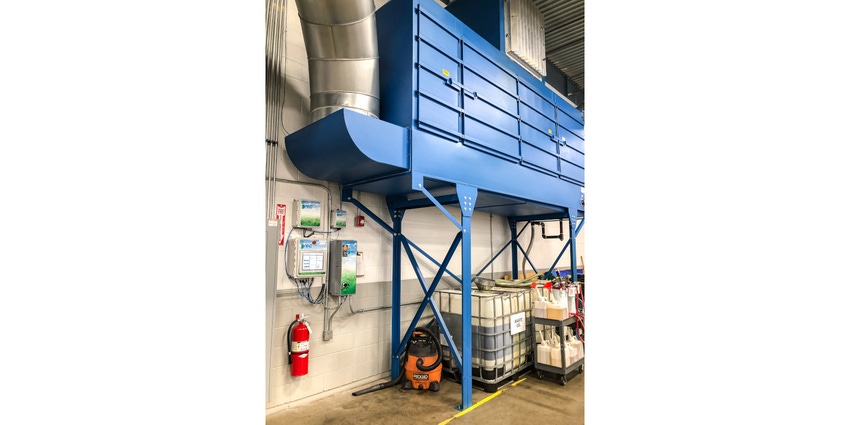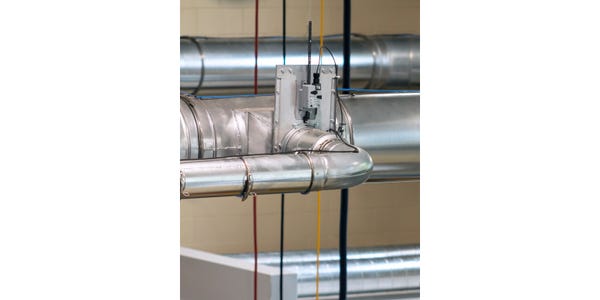Why have industrial dust collectors fallen behind in standardizing automation on equipment?
January 21, 2021

Zach Kieser, engineering manager, IVEC Systems
Automation is everywhere. Today your phone automatically syncs with your car, sending you notifications on support and servicing. You go to the store, and building automation permeates the retail and commercial experience. Walk into a bathroom, and the lights turn on. Automatic doors, faucets, toilets, and hand dryers are all becoming standard. You get home, pass by the video doorbell, and retrieve the package off the doorstep, the contents of which automatically renew and ship. The house is just the right temperature with scheduled HVAC controls, and the thought to adjust it doesn’t even occur to you.
So why have industrial dust collectors fallen behind in standardizing automation on equipment? Here are some of the reasons:
Long collector life
Lack of awareness
Lack of support
Collector Life
The primary reason for the lack of automation is the collector’s life cycle. If you look at a 15-year-old car, it probably has electric windows, antilock brakes, and air conditioning. It might have a CD player and cruise control. What will be missing are automatic doors, USB hookups, independent climate control for the passengers, and back up cameras. All things that are standard now, but back then the cost prevented them from even being offered.
That is how most dust collectors are still sold today, old technology. Historically, the dust collector market has been a price-driven, commodity market. Whoever can sell it the cheapest is going to win. These collectors were sold with big motors and blowers. The cabinets are thick, high-gauge steel, built to last. Dust collectors are still built that way, and systems last 20 years or more. Unfortunately, that means the same obsolete technology persists a lot longer than it should.
Just like your home, a control system can be created that can be retrofit onto a collector to bring outdated technology into the modern Industrial Internet of Things (IIoT) world. Along with this technology comes savings: imagine being able to drop the energy usage of that old system by 50%, 85%, or even more. Not only is that possible, it is a common result.
Awareness
Most dust collector manufacturers today still do not understand the energy savings by looking at the use. They still push systems running at full speed, sized for full usage all the time. Walk through your plant and take note of all the downtime at each operation. That welding robot waiting for parts is only welding 70% of the time. Why is air being extracted when the welding has stopped? That worker grinding parts is moving around the cell and checking those parts, as well as filling out the QC forms. He is only generating dust 30% of the time. Why pay to pull air from the cell when there is no dust? Maybe you have a wood shop with 16 machines but only eight employees. Why pull twice as much air as you need?
Because that is how it has always been done. Collectors were developed before automation was around, and energy was cheap. Today, energy is expensive, so understanding these retrofit opportunities can provide both economic and quality advantages in your facility.

In a retrofit situation, automation can be added to an existing system. Flexible and tested automation systems already exist and are compatible with any dust collector on the market no matter the manufacturer or age of the equipment. Sensors can be used at each operation to send a signal to the intelligent central control panel located at the motor. Algorithms can precisely adjust the speed of the motor and blower based on which operations are generating particulate. Only a partner with proven automation and dust collection experience can provide automation that allows the dust collector to provide only the air needed at any given moment, on demand. As the operations cycle on and off, the collector provides just enough air to meet the demand of work cells, eliminating wasted energy and reducing wear and tear on the system.
Properly tuned automation systems are like cruise control for your dust collector. Similar to wasting gas with hard starts and stops in your car, hard starts and stops on your dust collector waste energy. Typical systems are constantly running with the pedal to the metal, which is going to reduce the life of your vehicle while burning more fuel. The friction losses increase, and parts need to be replaced more often. Imagine running your dust collector in a softer, more fluid manner. Those bearings take less impact, the filters receive less dust load impaction, the whole system runs quieter. A proprietary automation system extends the life of the dust collector and its filters, while reducing the noise produced—whether the controls are on a brand new collector or retrofit onto an existing dust collector.
A typical dust collector lasts 15 to 20 years. How much do they cost to replace? $30,000? $100,000? $200,000? How much would it help to push off that reinvestment for another five years? In addition to the energy savings, a retrofit automation system can delay additional capital costs in the long run. Imagine waiting twice as long to change the filters. The total cost of ownership for the dust collector decreases dramatically when compared to a conventional system.
Support
So why aren’t more dust collector manufacturers implementing this technology themselves? It’s because they don’t understand automation. The dust collection industry is full of dinosaurs; they may have 40 years of experience in dust collection applications, but don’t understand the impact automation technology has on an entire system. Some may offer a simple VFD, but that may only deliver less than 10% of the potential savings and sometimes makes the dust problem worse. Adding to that, most dust collector suppliers generate revenue from filter sales, so increasing filter life means decreasing filter revenue.
The learning curve is steep, and the knowledge base is diverse. Knowing the application is not enough; you need to understand the gizmos – such as PLCs, communication protocols, sensors, speed controllers, gates, and more. These are just the basics of communication between devices. This compounds when you start looking at system lag, reaction times, and alarm functions. When looking at operational capacity, you want a highly reactive system. No one waits to push the gas until you are halfway up the hill or revs the engine as you start to descend the other side.
What about those safeties? How do you integrate the fire and explosion risks into the control loops of the system? The automation must have those supervisory functions to prevent dropout in the duct while mitigating energy usage. These custom algorithms need to be robust enough to not need constant tuning through automated oversite. The system must be proven.
This is why dust collector manufacturers have failed in implementing automation. To properly support the system, the provider needs to be both an expert in dust collection, as well as automation. With lack of understanding of either aspect, the project can have drastic and costly failures and inefficiencies. Nothing can replace the decades of experience needed to be successful in this approach where the two industries meet. Finding the proper partner is imperative to achieve air filtration on demand.
Zach Kieser is an engineering manager with IVEC Systems (New Berlin, WI). He has more than 15 years of experience designing and implementing filtration systems and automation controls technology for the manufacturing industry. For more information, call 866-670-4832, email [email protected], or visit www.ivecsystems.com.
You May Also Like


